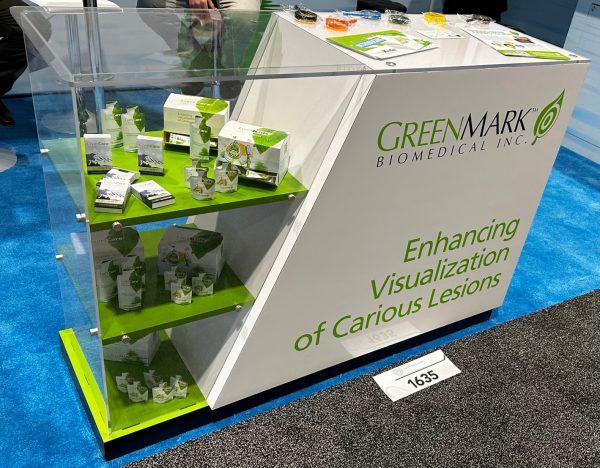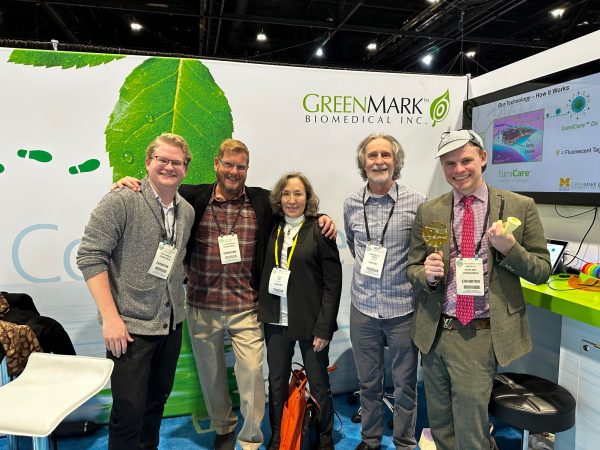A Future We Can All Smile About: Sequential Strategy for Dental Innovation Development at GreenMark Biomedical
Dental caries, caused by demineralization of enamel, is the most common chronic disease in the world. Globally, it is estimated that over $240 billion is spent annually on the management of dental caries and its complications, including both dental and medical expenditures. Caries is often treated surgically, beginning a cycle of increasingly invasive treatment that may eventually result in tooth loss or placement of an implant.
 However, there is a growing philosophy which focuses on preservation of enamel and teaches that early non-cavitated lesions, also called “white spot lesions”, can be repaired non-invasively by delivery of mineral ions and fluoride. Existing treatments include chairside fluoride varnishes, prescription high-fluoride toothpastes, over-the-counter lower fluoride toothpastes, and calcium phosphate-based remineralization agents. However, these available treatments do not completely repair the lesion. Subsurface porosity leaves the area mechanically weakened with unaesthetic white spots.
However, there is a growing philosophy which focuses on preservation of enamel and teaches that early non-cavitated lesions, also called “white spot lesions”, can be repaired non-invasively by delivery of mineral ions and fluoride. Existing treatments include chairside fluoride varnishes, prescription high-fluoride toothpastes, over-the-counter lower fluoride toothpastes, and calcium phosphate-based remineralization agents. However, these available treatments do not completely repair the lesion. Subsurface porosity leaves the area mechanically weakened with unaesthetic white spots.
To address the need for regenerating hydroxyapatite crystals within the depth of subsurface carious lesions, GreenMark Biomedical, in collaboration with partners from the University of Michigan (U-M), are developing a targeted biodegradable starch nanoparticle capable of delivering minerals and fluoride specifically to carious enamel. This technology was borne through the Ph.D. work of Dr. Nathan Jones, currently the V.P. of Technology at GreenMark. Foundational patents were licensed from the U-M to GreenMark, which was founded in 2016. The company has spearheaded the development of several dental products based on these technologies and maintains its laboratory at the U-M’s Innovation Partnerships Startup Incubator.
When GreenMark joined the ITP program in 2018, they had already been working with starch nanoparticles as part of a diagnostic product for the detection of early cavities. This product is now on the market as LumiCare™ Caries Detection Rinse and contains starch particles that penetrate through the porous surface and adhere to early-stage carious lesions for enhanced visualization. The ITP program has supported the development of therapeutic product based on the same foundational technology for the remineralization of caries.
Earlier activities supported by the Resource Center included characterization and optimization of starch particle compositions for remineralization of caries lesions. Together with MPWRM Resource Center and its experts, the team has developed a creative step-wise regulatory strategy and product launch plan for the therapeutic products that synergize with its diagnostic product, LumiCare™ rinse. With support from the Resource Center Market Assessment Core, the team conducted a focus group with dentists and dental hygienists to better understand the current clinical workflow in the diagnosis and treatment of non-cavitated caries, and how best to fit GreenMark products into this workflow. The focus group also explored benefits of remineralization to clinicians and their patients, as well as other drivers for making purchasing decisions and specific scientific/clinical evidence clinicians would want to see before incorporating this product into their practice.
 During the ITP program, the team faced technical challenges related to product form-factor and packaging. They recognized early on that the product needed to be delivered in a dry form to prevent premature release of the mineral payload, a feature critical to its performance. A previous iteration included a gel-based formulation that could be dispersed quickly on-site for easy brush-on application. However, it was soon discovered that attaining dosing accuracy with a small individually packaged quantity of powder was difficult. This led them to innovate a novel product formulation, resulting in the development of the dissolvable dental strip.
During the ITP program, the team faced technical challenges related to product form-factor and packaging. They recognized early on that the product needed to be delivered in a dry form to prevent premature release of the mineral payload, a feature critical to its performance. A previous iteration included a gel-based formulation that could be dispersed quickly on-site for easy brush-on application. However, it was soon discovered that attaining dosing accuracy with a small individually packaged quantity of powder was difficult. This led them to innovate a novel product formulation, resulting in the development of the dissolvable dental strip.
This new innovation and the learnings from the focus group was integrated into their product development process, and in 2023, GreenMark launched CrystLCare™ Biorestorative, Fluoride-Free, a product “designed to provide immediate and long-lasting dental sensitivity relief.” The launch of this product will facilitate the continued development of the remineralization product. Up next in their stepwise approach will be the submission of the Fluoride-Plus version for FDA review and approval.
Access to world-class research facilities, state-of-the art instrumentation and dental equipment, recognized dentistry experts, and commercialization resources (through the Resource Center), have accelerated our product development in a way that traditional research grant funding cannot
 GreenMark Biomedical has also been successful in raising external funds, leveraging the support from the Resource Center. To date, the team has won several SBIRs from NIH, pitch competitions, as well as the Cellerant Best of Class Technology Award. GreenMark has also been active in fundraising, securing various investments, including from the U-M’s venture investment program.
GreenMark Biomedical has also been successful in raising external funds, leveraging the support from the Resource Center. To date, the team has won several SBIRs from NIH, pitch competitions, as well as the Cellerant Best of Class Technology Award. GreenMark has also been active in fundraising, securing various investments, including from the U-M’s venture investment program.
With the learnings from the other products in its armamentarium and the step-wise regulatory strategy, GreenMark is poised to conduct a pre-submission with the FDA in the next year to review the requirements for the remineralization claims for the starch nanoparticles, with a De Novo submission to follow.
It is the hope of the GreenMark team that their technologies are tools that dentists can use to find caries in their early stage, treat them non-invasively, and monitor the benefits of those treatments, thereby preventing cavitation and the need for surgical restoration. This will advance the quality of dental care, increase accessibility to patients that are limited from dental care due to fear and cost, and improve oral health outcomes, which is a future we can all smile about.
For any questions/interests in the projects, please contact us at
translationalrc@umich.edu
